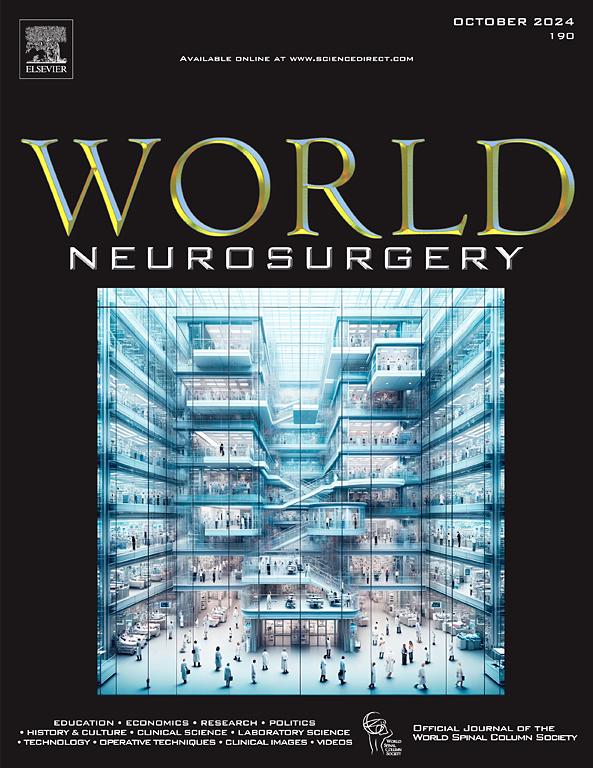Analysis of Risk Factors for Lumbar Spondylolisthesis: A Logistic Regression Study
IF 1.9
4区 医学
Q3 CLINICAL NEUROLOGY
引用次数: 0
Abstract
Objective
Lumbar spondylolisthesis is the forward displacement of one vertebra over another, commonly occurring at the L4/5 or L5/S1 levels. The condition is influenced by various risk factors, including age, body mass index (BMI), long-term physical labor, pelvic incidence (PI), and facet joint osteoarthritis. This study aims to identify the significant risk factors associated with lumbar spondylolisthesis through univariate and multivariate logistic regression analyses.
Methods
A retrospective analysis of 531 patients diagnosed with lumbar spondylolisthesis between September 2019 and September 2024 was conducted. Data were collected on age, BMI, PI, history of lumbar trauma, long-term physical labor, congenital pedicle dysplasia, osteoporosis, intervertebral disc degeneration, and facet joint osteoarthritis. Univariate logistic regression was used to screen for significant variables, followed by multivariate logistic regression to adjust for confounding factors. Receiver operating characteristic curve analysis was performed to assess the sensitivity of significant factors.
Results
Univariate analysis identified age, BMI, long-term physical labor, PI, and facet joint osteoarthritis as significant risk factors. Multivariate analysis confirmed that age (P = 0.035), BMI (P = 0.005), and facet joint osteoarthritis (P = 0.002) remained statistically significant. Interaction effect analysis did not reveal any significant interactions between variables. Receiver operating characteristic curve analysis showed that age, BMI, and facet joint osteoarthritis were key predictors of lumbar spondylolisthesis.
Conclusions
Age, BMI, and facet joint osteoarthritis (Grade III or above) were observed as potential risk factors for lumbar spondylolisthesis, with facet joint osteoarthritis showing the highest odds ratio. These findings indicate that degenerative changes in the spine, particularly those involving the facet joints, may contribute significantly to the development of lumbar instability, although further research is needed to establish causal relationships.
腰椎滑脱的危险因素分析:Logistic回归研究。
目的:腰椎滑脱是一个椎体在另一个椎体上的前移位,通常发生在L4/5或L5/S1节段。这种情况受各种危险因素的影响,包括年龄、BMI、长期体力劳动、骨盆发病率(PI)和小关节骨关节炎。本研究旨在通过单因素和多因素logistic回归分析,确定腰椎滑脱相关的重要危险因素。方法:对2019年9月至2024年9月诊断为腰椎滑脱的531例患者进行回顾性分析。收集年龄、BMI、PI、腰椎外伤史、长期体力劳动、先天性椎弓根发育不良、骨质疏松、椎间盘退变和小关节骨性关节炎的数据。采用单因素logistic回归筛选显著变量,然后采用多因素logistic回归调整混杂因素。采用ROC曲线分析评价显著因素的敏感性。结果:单因素分析确定年龄、BMI、长期体力劳动、PI和小关节骨性关节炎是重要的危险因素。多因素分析证实,年龄(p = 0.035)、BMI (p = 0.005)和小关节骨性关节炎(p = 0.002)仍有统计学意义。交互效应分析没有发现变量之间有显著的交互作用。ROC曲线分析显示,年龄、BMI和小关节骨性关节炎是腰椎滑脱的关键预测因素。结论:年龄、BMI和小关节骨性关节炎(III级及以上)是腰椎滑脱的潜在危险因素,其中小关节骨性关节炎的优势比最高。这些研究结果表明,脊柱的退行性改变,特别是涉及小关节的退行性改变,可能对腰椎不稳定的发展起重要作用,尽管需要进一步的研究来建立因果关系。
本文章由计算机程序翻译,如有差异,请以英文原文为准。
求助全文
约1分钟内获得全文
求助全文
来源期刊

World neurosurgery
CLINICAL NEUROLOGY-SURGERY
CiteScore
3.90
自引率
15.00%
发文量
1765
审稿时长
47 days
期刊介绍:
World Neurosurgery has an open access mirror journal World Neurosurgery: X, sharing the same aims and scope, editorial team, submission system and rigorous peer review.
The journal''s mission is to:
-To provide a first-class international forum and a 2-way conduit for dialogue that is relevant to neurosurgeons and providers who care for neurosurgery patients. The categories of the exchanged information include clinical and basic science, as well as global information that provide social, political, educational, economic, cultural or societal insights and knowledge that are of significance and relevance to worldwide neurosurgery patient care.
-To act as a primary intellectual catalyst for the stimulation of creativity, the creation of new knowledge, and the enhancement of quality neurosurgical care worldwide.
-To provide a forum for communication that enriches the lives of all neurosurgeons and their colleagues; and, in so doing, enriches the lives of their patients.
Topics to be addressed in World Neurosurgery include: EDUCATION, ECONOMICS, RESEARCH, POLITICS, HISTORY, CULTURE, CLINICAL SCIENCE, LABORATORY SCIENCE, TECHNOLOGY, OPERATIVE TECHNIQUES, CLINICAL IMAGES, VIDEOS
 求助内容:
求助内容: 应助结果提醒方式:
应助结果提醒方式:


